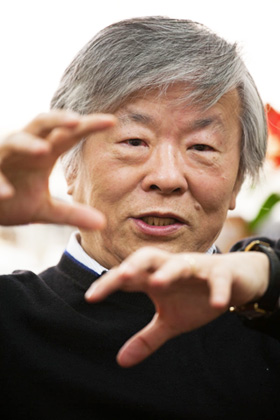Biohistory Journal
2013 Biohistory's Theme OPEN

Talking about life in the language of molecules
Susumu Tonegawa
Professor, Massachusetts Institute of Technology (MIT) Picower Institute for Learning and Memory
Director, RIKEN Brain Science Institute
Director, RIKEN-MIT Center for Neural Circuit Genetics
Profile
Susumu Tonegawa
Born 1939, Aichi Prefecture
Doctorate (Ph.D.) from University of California, San Diego, School of Biological Sciences Work experience- post-doctorate fellow at Salk Institute, member of Basel Institute for Immunology, etc.; Currently working
First encounter with molecular biology
I entered the Faculty of Science, Kyoto University, in 1959, a year before the 1960 Japan-US Treaty of Mutual Cooperation and Security. Although I had chosen chemistry as my major I started feeling that this feld was too traditional and rigit to my taste; I wanted study in a field that is new and exciting. About that time, a senior classmate, Hiromi Yamada, told me about a new research field, molecular biology. When I heard that I could study life at the molecular level, it sounded very attractive. I learned about the Operon Theory by Jacob and Monod, and I read their paper with a dictionary in one hand.
For graduate school, I applied for Professor Itaru Watanabe’s Laboratory at the Institute for Virus Research, Kyoto University. However, the professor was transferring to Keio University, and recommended that I study in the United States, home of molecular biology. With an introduction from Assistant Professor Takashi Yura, I went to University of California, San Diego (UCSD) in 1963.
Under Prof. Dulbecco’s tutelage
UCSD is located in La Jolla, California, where white sandy beaches and the deep blue ocean and clear sky spread out. I started my graduate career in this beautiful place. In Professor Masaki Hayashi's laboratory, I studied phages (viruses that infect bacteria) for gene transcription regulation. I also learned various molecular biology techniques, such as hybridization, which were a great help when I later transferred to Basel Institute for Immunology in Switzerland.
After earning my doctorate though, I moved to Professor Leonard Dulbecco’s Laboratory for my post-doctoral work at the Salk Institute located next door to UCSD.
This world-leading laboratory’s major research interest was cancer viruses which infect animal cells. There were many talented post-doctorates there, and a friendly competition to discover universal principles ensued. Being part of that group was a wonderful experience. Dr. Dulbecco was personally conducting pioneering experiments, and offered us advice with an overall point of view. He would talk about things from the big-picture, as if divinely possessed. Actually, a total of five Nobel Prize recipients emerged from his laboratory, including himself and me. Based on his advice, I moved to the Basel Institute for Immunology in the winter of 1971.
GOD mystery
At Basel, I met Dr. Charles Steinberg. He said the greatest challenge in immunology was "Generation of Diversity" or the GOD theory. How do our bodies use a finite number of genes to create such a diverse range of antibodies to fight against the infinite pathogens that invade our body? At that time, there were two lines of thinking. One was that germ cells innately contained the genetic information to generate diverse antibodies. The other was that the cells which produce antibodies undergo a maturation process that changes the genetic information. We then used DNA-RNA hybridization to estimate the number of genes involved in the lambda-light-chain variable-region of the antibodies based on the speed of hybridization. As a result, we discovered that a relatively small number of genes were involved, thus leaning towards the second line of thinking.
At the same time, we conducted research involving the rearrangement of antibody genes. On a cold winter weekend we obtained some astonishing results. From DNA obtained from fetal mouse cells, separated encoding genes for variable regions and constant regions of antibodies had recombined in the myeloma cells that produce antibodies. Genetic rearrangement had occurred through the process of differentiation, and it then became evident that various antibodies could be generated in this way. This achievement was heartily accepted at a symposium sponsored by Prof. James Watson in 1976, and in 1987 I was the sole recipient of the Nobel Prize in Physiology or Medicine.
Seeking the next mystery
Since moving to MIT, I have become increasingly interested in the science of the brain, where major mysteries still remain. During the first decade at MIT, we conducted research using knockout mice in immunology experiments. We are now using that same technology to tackle the question of creating memories. In 2013, we specifically identified neurons which become active during learning, and then activated those neurons by optogenetics method. From this experiment, reconstruction of memories themselves was shown to be possible.
Philosopher Rene Descartes advocated dualism, asserting that the mind and body are separate. However my position is that phenomena surrounding the mind are based on the behavior of nerve cells and their related molecules. In order to continue to discuss such things in the language of molecules, I want to be a scientist my entire life. What interest me most is the next experiment.

Translated by Walter Palmer
Proofread and rewritten by Tom Hibi








